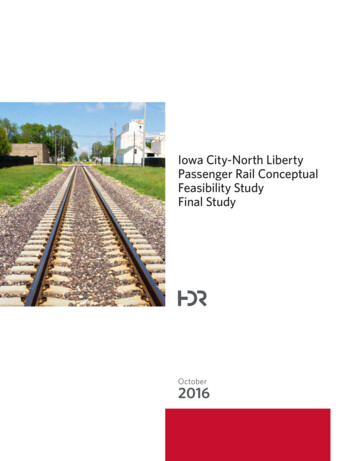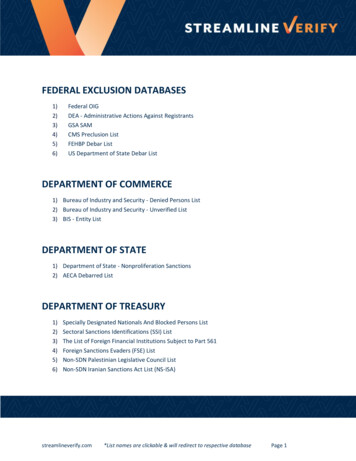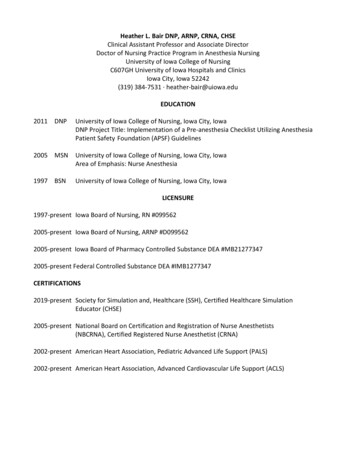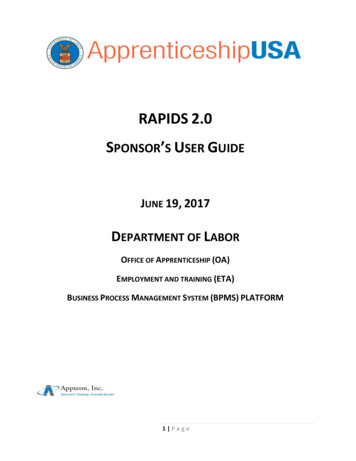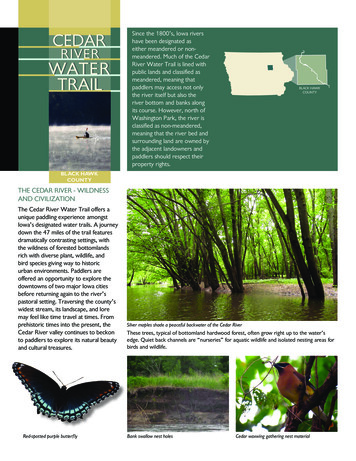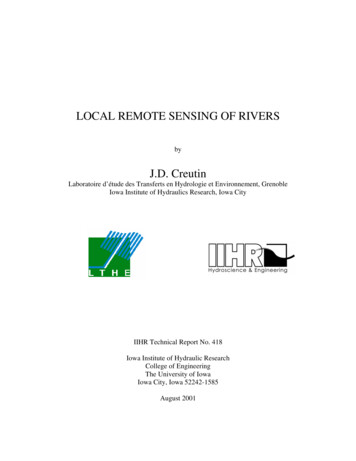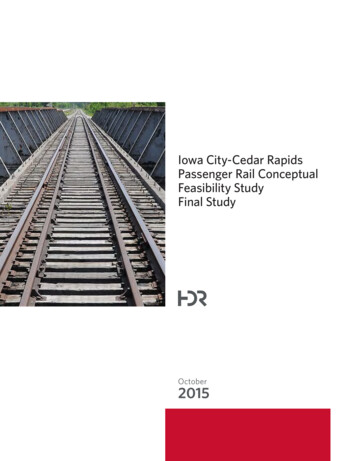
Transcription
Iowa City-Cedar RapidsPassenger Rail ConceptualFeasibility StudyFinal StudyOctober2015
ContentsExecutive Summary21. Background52. Prior Studies63. Existing Corridor Conditions94. Potential Corridor Passenger Rail ServiceCharacteristics205. Conceptual Cost Estimate266. Environmental Review347. Federal Safety and Governance RegulatoryRequirements368. Funding Availability Assessment45
Iowa City-Cedar Rapids Passenger Rail Conceptual Feasibility Study Final Study Executive SummaryThe purpose of the Iowa City-Cedar Rapids Passenger Rail Conceptual Feasibility Study is to examine theconceptual feasibility of a passenger rail service operating between Iowa City, Iowa, and Cedar Rapids, Iowa.The corridor under consideration in this study is the Cedar Rapids & Iowa City Railway (CRANDIC), an activefreight railroad over which no passenger rail services are offered at present. The 20.5-mile CRANDIC CorridorStudy Area (the Corridor) is between Gilbert Street in central Iowa City, Iowa, and the Eastern Iowa Airport inCedar Rapids, Iowa.CRANDIC and the Iowa Department of Transportation (Iowa DOT) selected HDR as its consultant teamfor the study. The railroad, Iowa DOT, and other project stakeholders participated in the study throughcoordination with HDR.The study was divided into the following tasks, which culminated in this study report: Background – Describe the background of the passenger rail study. Prior Studies – Provide a high-level assessment of prior studies of the Corridor’s passenger rail feasibility,service territory, and transit and ridership potential. Existing Corridor Conditions – Describe the existing conditions and infrastructure on the Corridor. Potential Corridor Passenger Rail Service Characteristics – Describe the general characteristics of themodes of passenger rail service available and their applicability to the Corridor. Conceptual Cost Estimate – Develop representative conceptual capital and operations and maintenancecosts for each mode of passenger rail service assessed for potential implementation on the Corridor. Environmental Review – Describe the general Environmental Review process for constructing andimplementing passenger rail service. Federal Safety and Governance Regulatory Requirements – Describe the basic federal regulatoryrequirements for the implementation of passenger rail service. Funding Availability Assessment – Describe the general federal funding streams and availability for eachmode of passenger rail service.Applicability of Modes to the CorridorThree passenger rail modes in use on other passenger rail corridors across the U.S. were studied and analyzedfor potential applicability to the CRANDIC Corridor and are described in detail later in this study. Thesemodes are: Streetcar Light Rail Transit Commuter Rail TransitThe applicability of each mode to the Corridor took into account the following considerations: Typical service range Typical average capacity per vehicle Typical station spacing Maximum and average operating speeds Typical service frequency Typical technology characteristics Typical corridor and infrastructure requirements Typical capital costs for service implementation Typical annual operations and maintenance costsThe streetcar mode typically uses a variety of small vehicles and tends to operate like a downtown peoplemover linking downtown visitors, employees, and residents to jobs, shopping, and entertainment. Electrified2
Iowa City-Cedar Rapids Passenger Rail Conceptual Feasibility Study Final Study streetcar networks characteristically operate over short distances (typically 4 miles or less), provide serviceevery 5-15 minutes, and operate within city streets in urban areas. The typical average capacity per vehicle is60 passengers. Maximum speeds are typically up to 35 mph.The Light Rail Transit (LRT) mode is typically a single vehicle type operating over an electrified network in atraffic lane or exclusive right-of-way. The typical operating range for an LRT is up to 20 miles and service istypically provided every 5-15 minutes. In some cases, LRT operations can share track with an active freightrailroad, but only if the two modes are temporally separated (e.g., LRT operates during daylight, freight atnight). The typical average capacity per vehicle is 225 passengers. The power supply that allows the rapidaccelerating and longer distance operating performance typical of the LRT requires overhead catenary andtraction power substations, which have a significant cost to build, operate, and maintain. Maximum speedsare typically 45-65 mph.Commuter Rail Transit (CRT) typically employs either push-pull diesel locomotive powered commutertrains or self-propelled Diesel Multiple Unit (DMU) trains. The typical operating range for CRT is up to 50miles and service is typically provided every 30 or more minutes. The typical average capacity per vehicleor train is between 250 and 1,000 passengers. The type and intensity of land uses in the Corridor suggest apassenger rail service with fairly long station spacing and peak period focused service, a service pattern thatis characteristic of CRT. DMU trains are versatile and typically offer performance characteristics suitable tolikely station spacing in the Corridor and they provide a suitable capacity, flexibility to expand train length asnecessary, and potential for use on city streets in downtown areas, if required. Maximum speeds are typicallyup to 79 mph.Potential Implementation and Operating and Maintenance CostsA detailed cost estimate was not performed due to the limited nature of the study. Instead, costs wereobtained by extracting costs from other streetcar, LRT, and CRT corridors recently implemented in the U.S.These costs were adjusted for the length of corridor, potential number of stations, frequency of service,and other attributes specific to the Corridor. The findings of the technical work described above and thedevelopment of the conceptual cost estimate by mode undertaken for this study are summarized in FigureES-1 below. The study determined that the lowest cost option for implementation of passenger rail serviceon the CRANDIC Corridor between Iowa City and the Eastern Iowa Airport at Cedar Rapids is the CommuterRail Transit (CRT) mode. Probable corridor implementation costs would vary depending on the number ofstations, the length of the corridor, and the frequency of service. Savings could potentially be realized byreducing the number of stations, frequency of service, passenger capacity, and maximum speeds.The probable capital cost for implementation based on other recently implemented corridors would beexpected to range from 250 million to 520 million, and annual operations and maintenance costs would beexpected to range between 5.6 million and 6.7 million, in 2015 dollars, as shown in Figure ES-1 below.Figure ES-1. Conceptual Cost Summary for Passenger Rail Implementation on CRANDIC CorridorS T R E E TC A RLIGHT R AIL TR ANSITCO M M U T E R R A I LTR ANSITPotential Capital Cost to ImplementPassenger Rail Service on theCRANDIC Corridor 1.07 - 1.64 billion 860 million - 1.33 billion 250 million - 520 millionPotential Annual Operations andMaintenance Cost on the CRANDICCorridor 5.6 million - 6.7 million 5.6 million - 6.7 million 5.6 million - 6.7 millionAT T R I B U T E S A N D M O D EPhased implementation of passenger rail service in the CRANDIC Corridor could be considered bystakeholders based upon need for the service and the availability of funding. Passenger rail service couldbe phased geographically to reduce the initial cost of service implementation. The cost to implement aCommuter Rail Transit (CRT) mode of passenger rail operation over the 9.5-mile Iowa City-North Liberty3
Iowa City-Cedar Rapids Passenger Rail Conceptual Feasibility Study Final Study segment of the Corridor in a potential first phase, for example, are anticipated to range from 114 millionto 238 million in capital costs and between 2.6 million and 3.1 million annually in operations andmaintenance costs. The acquisition of reconditioned secondhand CRT equipment, if available, could alsopotentially lower the capital cost for procurement of equipment. Capital costs could potentially be reducedfurther by decreasing the number of stations or by phasing the implementation of stations and stationamenities and the construction of a new layover and maintenance facility where trains would be stored andmaintained between scheduled operations.Next StepsProject stakeholders will determine the feasibility of further study of the potential for implementation ofpassenger rail service on the Corridor. More detailed future analysis and study could include ridership andrevenue forecasts, more detailed cost estimates, financial plan, conceptual operating and phasing plans,conceptual station designs and infrastructure engineering, environmental fatal-flaws analysis and screening,and the potential for phased implementation of passenger rail service.4
Iowa City-Cedar Rapids Passenger Rail Conceptual Feasibility Study Final Study 1. BackgroundThe Iowa City-Cedar Rapids Passenger Rail Conceptual Feasibility Study will examine the conceptualfeasibility of a passenger rail service operating in the corridor between Iowa City, Iowa, and Cedar Rapids,Iowa. The corridor under consideration in this study uses the Cedar Rapids & Iowa City Railway (CRANDIC).The CRANDIC Corridor Study Area (the Corridor) is between Gilbert Street in central Iowa City, Iowa, and theEastern Iowa Airport in Cedar Rapids, Iowa, a total of 20.5 miles.Project stakeholders are the public and private entities that funded this feasibility study: Cedar Rapids & Iowa City Railway (CRANDIC) Iowa Department of Transportation (Iowa DOT) Metropolitan Planning Organization of Johnson County, Iowa (MPOJC) Johnson County, Iowa City of Iowa City, Iowa City of Coralville, Iowa City of North Liberty, Iowa University of IowaThe goal of this study is to enable project stakeholders of the proposed passenger service to understand thedifferent modes that are available for passenger rail service in the Corridor; to understand the probable capitaland operating and maintenance costs of each of the modes; and to consider service frequencies, servicecapacities, and the regulatory and funding environment for implementing a passenger rail service in theCorridor. The modes of passenger rail service that are currently available are assessed in this study for theirconceptual feasibility for the Corridor alignment, potential stations, other uses of the existing railroad, and thepassenger transportation vision for the Corridor. These modes include: Streetcar, electrified Light Rail Transit (LRT), electrified Commuter Rail Transit (CRT), using either push-pull diesel locomotive powered commuter trains, or selfpropelled Diesel Multiple Unit (DMU) trainsMore detailed analysis and study for potential implementation of passenger rail services on in the Corridor,including ridership and revenue forecasts, detailed cost estimates, financial plan, conceptual operating andphasing plan, conceptual station designs and engineering, environmental fatal-flaws analysis and screening,and the potential implementation of passenger rail service over an existing CRANDIC route or an alternateroute between the Eastern Iowa Airport at Cedar Rapids and downtown Cedar Rapids, may be explored byproject stakeholders in future study phases.5
Iowa City-Cedar Rapids Passenger Rail Conceptual Feasibility Study Final Study 2. Prior StudiesTwo prior transit studies have been completed for the Iowa City-Cedar Rapids travel corridor, which includesthe CRANDIC Corridor, in the last decade: Cedar-Iowa River Rail Transit Project Feasibility Study, 2006 Iowa Commuter Rail Transportation Study, 2014These studies are summarized below.2.1 Cedar-Iowa River Rail Transit Project Feasibility StudyThe Cedar-Iowa River Rail Transit Project Feasibility Study focused upon passenger rail options usingseveral regional and short line railroad rights-of-way, primarily linking Iowa City and Cedar Rapids. Thestudy considered: Infrastructure requirements and capital costs Service plan and potential conflicts Potential ridership Federal funding opportunitiesThe alignment most applicable to this study is the CRANDIC Corridor extending north from Iowa City throughthe University of Iowa campus and passing by the Eastern Iowa Airport in Cedar Rapids en route to downtownCedar Rapids. The southern portion of the route could potentially serve a southbound commuter marketfrom North Liberty and Coralville to the University of Iowa campus and downtown Iowa City. Significantfreight movements north of the Eastern Iowa Airport would make passenger service difficult to implement todowntown Cedar Rapids. The Eastern Iowa Airport could offer a reverse commute market, however, providinga destination anchor at the north end.Within this corridor, the report provided information for both options, offering a commuter option from thenorthern suburbs of North Liberty and Coralville to Iowa City, or the larger scale project extending to theEastern Iowa Airport at Cedar Rapids. The capital and operating costs in 2006 dollars and estimated ridershipfor the two options are summarized in Table 1 below.Table 1. Summary Service StatisticsC A P I TA L CO S T SSERVICETR ACK /BRIDGESEQUIPMENT(PURCHASEDO R L E A S E D)S TAT I O N S& L AYOV E RFA C I L I T I E ST O TA LRIDERSHIPA N N UA LO P E R AT I N GCOSTSN. Liberty – Iowa CityCommuter Service (2006) 1,448,000 8,400,000 8,800,000 18,648,000742 4,078,000N. Liberty – Iowa CityCommuter Service (2030) 6,615,000 12,600,00 8,800,000 28,015,0001,336 6,797,000Eastern Iowa Airportto Iowa City CommuterService (2006) 4,107,000 4,500,000 12,800,000 21,407,000837 5,014,000Eastern Iowa Airportto Iowa City CommuterService (2030) 14,981,000 7,500,000 12,800,000 35,281,0001,991 11,960,000The capital cost allowed for CRANDIC to require rail replacement prior to initiating 30 mph service. Anyof these alternatives require a significant capital investment. The operating costs are also significant, andincrease substantially in response to ridership growth. The annual operating costs are particularly importantin that they tend to grow over time, and generally require a 60-75 percent subsidy.6
Iowa City-Cedar Rapids Passenger Rail Conceptual Feasibility Study Final Study The ridership forecasts shown in the table above are based upon existing and projected travel flows in theregion, and characteristics of the proposed services. The longer route extending to the Eastern Iowa Airportgenerates somewhat higher ridership as would be expected. In many markets, the airport service can bemore of a benefit to the airport employees than airport passengers. In general, these ridership levels are notsubstantial. Modern commuter rail projects, excluding the legacy systems such as in Boston, Massachusetts,and Chicago, Illinois, typically generate 2,000-5,000 trips per day. Light Rail Transit (LRT) projects usuallycarry 20,000 daily passengers or more.The report also identifies the benefits of transit-oriented development (TOD) to potential ridership. TODdevelopment tends to be higher density with mixed-uses not permitted by traditional zoning codes. Inaddition, the development is more pedestrian oriented than typical suburban patterns, increasing the numberof trips that can be made without motorized vehicles. This development pattern is particularly successful ingenerating transit riders in large urban areas with high frequency rail service proximate to the development.The report identified several potential federal funding approaches. At the time of the report, there was someopportunity to pursue federal funding under an “exempt” status for a project requesting under 25 million.That option is no longer available. The Small Starts program identified later in the report has been furtherdeveloped by the Federal Transit Administration (FTA) for projects requesting less than 75 million in capitalfunding. The FTA requirements are less robust than for the larger New Starts projects, but remain significant.Projects with lower daily ridership and longer passenger trips typical of corridors of this nature generallydo not perform well under the FTA criteria. This report does not explicitly evaluate the potential for federalfunding of a project. It suggests, however, that some type of excursion service would be much easier toimplement than a regular commuter service.2.2 Iowa Commuter Rail Transportation StudyThe Iowa legislature directed the Iowa Department of Transportation (Iowa DOT) to conduct a study thatwould identify the existing and future commuter needs in the Interstate 380 Corridor between Cedar Rapidsand Iowa City and determine the viability of various commuter transportation improvements to address thoseneeds. The study relied heavily upon input from major employers in the Cedar Rapids-Iowa City study areaand the results of two public surveys that produced nearly 1,000 responses from study area commuters.The U.S. Census Bureau American Community Survey 2006-2010 five-year samples indicated a dailycommuter market in the Cedar Rapids-Iowa City corridor of about 7,500 daily commuters. Over 90 percentof the commuter survey respondents indicated that transportation improvements were necessary in thecorridor. About 70 percent indicated that they would consider use of a public bus for their commute.A wide range of transit options were considered to address commuting needs in the corridor. Based upon theprior Cedar-Iowa River Rail Transit Project Feasibility Study described above, commuter rail service was notconsidered for short-term implementation due to the capital and operating costs. The study recommended apackage of transit improvements, including: Public interregional express bus service connecting Cedar Rapids, North Liberty, Coralville, and Iowa City. Subscription bus service tailored to specific markets. Public vanpools using vehicles supplied by public agencies and driven by one of the vanpool members. Public carpool program using one of the individual’s private automobile.In addition to these services, the report recommended a package of infrastructure and technologyimprovements to enhance the effectiveness of the various service improvements. That package includes: Park and ride facilities at convenient locations proximate to the primary commuting corridor, for use bybus, van, and carpool passengers. Regional commuter travel information providing comprehensive, local travel information such as routing,pick up points, and fares.7
Iowa City-Cedar Rapids Passenger Rail Conceptual Feasibility Study Final Study Transit priority measures that make transit and ridesharing options more attractive by reducing travel timeand improving service reliability. Guaranteed Ride Home that offers a convenient, affordable transportation alternative in case of anemergency outside of scheduled transportation provided by all modes.The report indicated that this combination of services and supporting infrastructure can be implemented inthe short term in order to significantly expand and enhance transportation options within the I-380 corridor.8
Iowa City-Cedar Rapids Passenger Rail Conceptual Feasibility Study Final Study 3. Existing Corridor ConditionsThis section describes existing conditions of the Corridor, including the condition of the CRANDICinfrastructure, demographics and geographic characteristics of the service area, and other transportationinfrastructure and services. It includes a brief history of previous passenger rail transportation services inthe Corridor.3.1 Corridor Service Area, Intersections, and ConnectivityThe CRANDIC Corridor connects Iowa City in Johnson County and Cedar Rapids in Linn County – two of theState of Iowa’s fastest growing metropolitan areas. According to U.S. Census data, the Iowa City and CedarRapids Metropolitan Statistical Areas were estimated to have a combined population of 428,242 as of July 1,2014.1The north-south CRANDIC Corridor, and the parallel Interstate Highway 380 Corridor, sit astride growingresidential, commercial, and light industrial development – particularly in Iowa City, Coralville, andNorth Liberty.The CRANDIC Corridor intersects with: Universities and Colleges – including the University of Iowa in Iowa City and Kirkwood CommunityCollege in Cedar Rapids. Hospitals – including the University of Iowa Hospitals and Clinics, Iowa City Veterans AdministrationHospital, and Mercy Hospital in the Iowa City area. Airport – including access to the Eastern Iowa Airport in Cedar Rapids. Shopping Destinations – including downtown Iowa City, the Iowa River Landing in Coralville, and CoralRidge Mall in Coralville. Recreation – including University of Iowa sporting and cultural events, and access to parks andmulti-use trails. Employment – including access to several major area employers.A passenger service in the CRANDIC Corridor could potentially relieve vehicular congestion andimprove traffic safety on parallel Interstate 380 between Iowa City and Cedar Rapids, and also provide atransportation alternative to driving for students, workers, business and leisure travelers, retail shoppers, theelderly, and hospital patients. In 2014, it was estimated that over 7,500 commuters traveled between theCedar Rapids and Iowa City metropolitan areas daily, and that most of these commuters were using Interstate380 during peak travel periods. 2 A passenger rail service in the CRANDIC Corridor could also reduce traveltimes and provide a transportation alternative for area commuters who drive to Iowa City and the Universityof Iowa facilities from Coralville, Oakdale, North Liberty, and other outlying locations. Many of thesecommuters are presently transit dependent, as they drive to Iowa City and park their vehicles in parking lotsand then continue their commute on local transit buses.Passenger rail service on the CRANDIC could also potentially provide intermodal connectivity with existingand future rail, transit, bus, and air services in the region as described below.Intercity Passenger Rail – Implementation of a twice-daily intercity passenger rail service between Chicagoand Moline, Illinois, and Iowa City is presently under study by Iowa DOT and the Illinois Department ofTransportation (Illinois DOT). Passenger rail service on CRANDIC could potentially terminate at ClintonStreet, one block south of a potential Iowa City station for the intercity passenger rail service, which wouldprovide a transfer point between the two services.U.S. Census, Annual Estimates of the Resident Population: April 1, 2010 to July 1, 2014 – United States – Metropolitan Statistical Area; 2014Population Estimates; U.S. Census website jsf/pages/productview.xhtml?src bkmk); July31, 20152Iowa Commuter Transportation Study; Iowa Department of Transportation, December 20143Ibid19
Iowa City-Cedar Rapids Passenger Rail Conceptual Feasibility Study Final Study Public Transit – Passenger rail service on the CRANDIC could potentially provide access to and enhanceexisting and future connecting public transit systems in the Corridor. Potential connections could be madewith Iowa City Transit buses at Iowa City; University of Iowa CAMBUS network at Iowa City; Coralville Transitbuses at North Liberty, Coralville, and Iowa City; and Cedar Rapids Transit buses at the Eastern Iowa Airportin Cedar Rapids. 3Intercity Buses – Burlington Trailways and Greyhound serve the Court Street Transportation Center on CourtStreet in downtown Iowa City, which is located in close proximity to the CRANDIC Corridor.Airport – The CRANDIC Corridor is in close proximity to the terminal of the Eastern Iowa Airport on thesouth side of Cedar Rapids. A surface pedestrian connection or shuttle bus service could potentially beestablished between a rail station on the Corridor and the Eastern Iowa Airport. The Airport presently hostsseveral daily domestic flights for Allegiant Air, American Eagle, Delta Airlines, Frontier Airlines, and UnitedAirlines. According to statistics from the Eastern Iowa Airport, approximately 1,132,991 passengers used theairport during 2014.43.2 Corridor HistoryThe Cedar Rapids & Iowa City Railway (CRANDIC) Corridor was constructed as a high-speed interurbanbetween its namesake cities by the Iowa Railway & Light Company during 1903 and 1904. The railroadprovided electrified passenger and freight service over the 27 miles between Cedar Rapids and Iowa Citystarting on August 13, 1904. 5 Figure 1 below shows the standard of track construction and style of passengerequipment employed when the railroad began operations.Source: CRANDICFigure. 1 Early Interurban Car on the CRANDICThe map in Figure 2 below shows the route of the CRANDIC Corridor and its proximity to other railroad linesin the region today. The bold red line identifies the CRANDIC Corridor Study Area between Iowa City and theEastern Iowa Airport in Cedar Rapids.45The Eastern Iowa Airport CY Total Passengers 2014; Eastern Iowa Airport website; www.eiairport.org; July 27, 2015Cedar Rapids & Iowa City Railway (CRANDIC) website; www.crandic.com; July 27, 201510
Iowa City-Cedar Rapids Passenger Rail Conceptual Feasibility Study Final Study amNorwayWalfordSwisherLisbonEASTERN IOWAAIRPORTElyShueyvilleSolonCou FallsAmanaSouthAmanaNorth LibertyTiffinOxfordCoralvilleIOWA CITYRAILROADSCRANDICUnion PacificIowa InterstateIowa NorthernCanadian NationalOakdaleJOHNSONCOUNTYHillsFigure 2. CRANDIC Corridor Between Cedar Rapids and Iowa City Source: HDRThe height of CRANDIC interurban operations began when the railroad upgraded its passenger car fleet in1939, via the acquisition of second-hand high-speed electric interurban cars. These cars proved capable ofproviding faster and more efficient interurban service over the Corridor, and attracted record ridership.6 Figure3 below shows a high-speed interurban car at Swisher that supported the enhanced passenger operation.Figure 3. High-Speed Interurban Car on the CRANDIC at Swisher6IbidSource: CRANDIC (William D. Middleton )11
Iowa City-Cedar Rapids Passenger Rail Conceptual Feasibility Study Final Study By 1944, CRANDIC operated 17 interurbans each way daily, which provided almost hourly service betweenCedar Rapids and Iowa City, from approximately 5 a.m. until 12 midnight. In 1945, CRANDIC reached thezenith of ridership carrying a record 573,307 patrons.7 Figure 4 below shows CRANDIC’s station locationsand frequent passenger service offerings in the Corridor, as they existed in October 1946.Figure 4. CRANDIC Passenger Service Timetable, October 1946Source: HDROwing to the surging popularity of the automobile and the dominance of hard-surfaced roadways in theimmediate post World War II era, CRANDIC ridership declined sharply to just 188,317 patrons in 1952.Passenger rail service was discontinued altogether on May 30, 1953, and abandonment of remaininginterurban trackage in city streets and full dieselization of freight railroad operations soon followed.8 TheCRANDIC’s freight service and network grew considerably in the ensuing years. In 2014, the short linerailroad had 54 route miles and continued to provide direct access to several large industries and multipleconnections with other railroads in the Cedar Rapids area. CRANDIC carried 99,334 carloads during 2014.The CRANDIC’s former interurban line – today known as CRANDIC Division 2 – once served as a primaryartery for considerable volumes of freight rail traffic originating in Cedar Rapids that was interchanged to theIowa Interstate Railroad (IAIS) at Iowa City for furtherance to the Quad Cities of Iowa and Illinois; Chicago andPeoria, Illinois; and Council Bluffs, Iowa. The interchange of freight rail traffic between the carriers was shiftedfrom Division 2 and Iowa City, west to South Amana, Iowa, and over another CRANDIC line in 2001.Today, the CRANDIC’s former interurban line is used by CRANDIC to serve a considerable industrial base insouth Cedar Rapids and one rail shipper in North Liberty. CRANDIC leased the former interurban line withincentral Iowa City, as well as its connecting line from Iowa City to Hills (former Chicago, Rock Island & PacificRailroad trackage acquired in 1980) to IAIS in 2012. Present freight operations in the CRANDIC Corridor aredescribed later in this section.78IbidIbid12
Iowa City-Cedar Rapids Passenger Rail Conceptual Feasibility Study Final Study 3.3 Present General Corridor CharacteristicsThe CRANDIC Corridor under consideration in this study includes the segment of CRANDIC Division 2between Gilbert Street in central Iowa City (Milepost 25.8) and the Eastern Iowa Airport at Cedar Rapids(Milepost 5.3), for a total of 20.5 miles. This section contains an assessment of the present generalcharacteristics and conditions of the CRANDIC Corridor, as observed in May 2015.3.3.1 Timetable StationsTimetable stations on CRANDIC Division 2 and their railroad milepost location within the CRANDIC Corridorare listed in Table 2 below.Table 2. CRANDIC Division 2 Timetable StationsT I M E TA B L E S TAT I O NKonigsmark (Eastern Iowa Airport in Cedar Rapids)CR ANDIC MILEPOST5.3Airport Siding6.1Swisher8.3Cou Falls10.6Mid-River13.3North Liberty16.7Oakdale19.8Great Lakes22.3Coralville22.9Iowa City25.1Source: CRANDIC3.3.2 Track ConfigurationThe CRANDIC Corridor is comprised of a single main track with sidings to accommodate meet-pass eventsbetween trains, switching of online freight customers, and to stage and store rail cars. Short sidings exist onthe Corridor just outside the Study Area at Cedar Rapids, and within the Study Area at Airport Siding, MidRiver, North Libert
The corridor under consideration in this study is the Cedar Rapids & Iowa City Railway (CRANDIC), an active freight railroad over which no passenger rail services are offered at present. The 20.5-mile CRANDIC Corridor Study Area (the Corridor) is between Gilbert Street in central Iowa City, Iowa, and the Eastern Iowa Airport in Cedar Rapids, Iowa.
